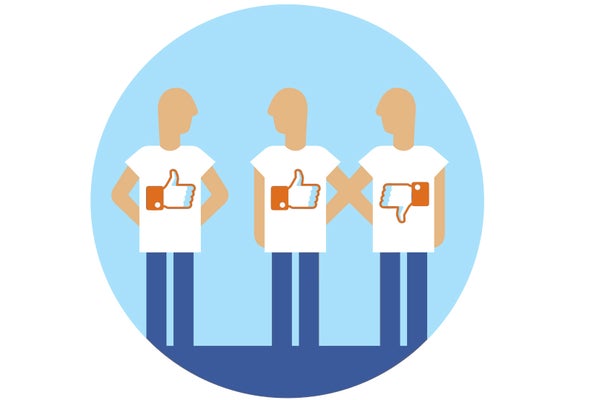People generally spend time with others who are like them, making it easy for data scientists to infer individuals' attitudes or personality attributes by analyzing their online and real-world social networks. Researchers call this tendency to seek out like-minded people “homophily.” Think of the old adage “birds of a feather flock together,” says Johan Ugander, a management science and engineering researcher at Stanford University, who studies this topic.
But in a surprising twist, Ugander and his graduate student Kristen M. Altenburger have found that some people are consistently drawn to those with certain dissimilar attributes. The researchers call the variation introduced by this phenomenon “monophily.” Scientists previously assumed that heterogeneity would make it harder to draw conclusions about people based on friend networks. But Ugander and Altenburger's research demonstrates that monophily produces an effect whereby a person's friends of friends are similar to them in ways that immediate friends may not be. This could make it easier than anticipated for scientists to infer personal characteristics that might otherwise remain hidden—and it is one more way for data miners to trace personal information.
In a study published online in March in Nature Human Behaviour, Ugander and Altenburger analyzed three different types of networks: an online social network, a network of political blogs and a well-studied terrorist communication network. Scientific American spoke with Ugander about the research and its implications for individual privacy. An edited excerpt follows.
On supporting science journalism
If you're enjoying this article, consider supporting our award-winning journalism by subscribing. By purchasing a subscription you are helping to ensure the future of impactful stories about the discoveries and ideas shaping our world today.
Did the idea that “opposites attract” lead you to study monophily?
What led us to this project was the basic puzzling fact that there is barely any gender homophily, or consistent gender clustering, in online social networks. There is a lot of age clustering. The fact that there is almost no gender homophily has consequences for information diffusion and for data privacy. It turns out you can still predict people's gender based on the gender of their friends of friends by harnessing variability in the network—which is the counterintuitive starting point we spend most of the study trying to unpack and explain.
Is having Facebook friends with different political views an example of monophily?
With respect to political affiliation, you tend to surround yourself with similar others. That said, we did see a statistically significant amount of friend dissimilarity when it came to political affiliations in blogger networks. There are some people who are crossovers: they run liberal blogs but tend to link to conservative blogs, or vice versa.
Have you seen changes in how social networks are being studied in light of privacy concerns?
I view myself as somebody who tries to sound alarms and look at all the ways it is possible to predict things about individuals. There has been a healthy public conversation recently about the importance of protecting the information contained in connections in these online social networks. [Disclosure: Ugander was affiliated with Facebook Data Science from 2010 to 2014.]
On the other hand, there are benefits to understanding people better based on their position in a social network. A lot of social sciences research is focused on identifying authentic causal relationships and ruling out confounding factors. I am interested in understanding the extent to which we can describe individuals when we maybe don't have demographic data but do have this very rich network of social relationships.
Are you concerned that your research could be used for nefarious purposes?
Always. When one builds tools, one has a responsibility for how those tools are used. The main algorithm we study has been in the scientific literature since 2009. It was previously assumed that this method works for predicting an individual's attitudes or attributes if there are between-friend similarities in the network. But we are showing you do not need homophily, or likeness, for this approach to be effective.
